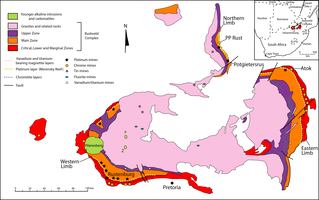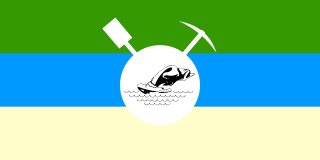Platinum and platinum group metals are produced in Zimbabwe and South Africa. Of the multitudes of companies involved in producing platinum group metals in these two countries, these are the principal operators:Citation needed
Platinum and platinum group metals are produced in Zimbabwe and South Africa. Of the multitudes of companies involved in producing platinum group metals in these two countries, these are the principal operators:Citation needed
World's leading platinum producer.
There are 6 platinum group elements:
The platinum-group metals are six noble, precious metallic elements clustered together in the periodic table. These elements are all transition metals in the d-block.
Anglo American plc is a British listed multinational mining company with headquarters in London, England. It is the world's largest producer of platinum, with around 40% of world output, as well as being a major producer of diamonds, copper, nickel, iron ore, polyhalite and steelmaking coal. The company has operations in Africa, Asia, Australia, Europe, North America and South America.

The Bushveld is a sub-tropical woodland ecoregion of Southern Africa. The ecoregion straddles the Tropic of Capricorn and constitutes the southern part of the Zambezian region. It encompasses most of Limpopo and a small part of North West in South Africa, the Central and North-East Districts of Botswana and the Matabeleland South and part of Matabeleland North provinces of Zimbabwe. The Kruger National Park has a number of 'Bushveld' camps, but these are strictly speaking in the lowveld, as these terms are sometimes used interchangeably. Although their limits are somewhat blurred, lowveld is generally restricted to the more easterly parts of South Africa and Zimbabwe.
Anglo American Platinum Limited is the world's largest primary producer of platinum, accounting for about 38% of the world's annual supply.

The Bushveld Igneous Complex (BIC) is the largest layered igneous intrusion within the Earth's crust. It has been tilted and eroded forming the outcrops around what appears to be the edge of a great geological basin: the Transvaal Basin. It is approximately 2 billion years old and is divided into four different limbs: the northern, southern, eastern, and western limbs. The Bushveld Complex comprises the Rustenburg Layered suite, the Lebowa Granites and the Rooiberg Felsics, that are overlain by the Karoo sediments. The site was first publicised around 1897 by Gustaaf Molengraaff who found the native South African tribes residing in and around the area.

The Great Dyke is a linear geological feature that trends nearly north-south through the centre of Zimbabwe passing just to the west of the capital, Harare. It consists of a band of short, narrow ridges and hills spanning for approximately 550 kilometres (340 mi). The hills become taller as the range goes north, and reach up to 460 metres (1,510 ft) above the Mvurwi Range. The range is host to vast ore deposits, including gold, silver, chromium, platinum, nickel and asbestos.

The Royal Bafokeng is the ethnic homeland of the Bafokeng people, a Setswana-speaking traditional community. The monarchy covers 1,000 square kilometers (390 sq mi) in the North West Province of South Africa. The capital is Phokeng, near Rustenburg. "Bafokeng" is used to refer to both the tribal grouping as well as the land its members inhabit. The kingdom's current ruler is Kgosi (King) Leruo Molotlegi. Who has reigned since 2000. The Bafokeng first settled in the Rustenburg Valley in c.1450AD, the presence of the ceramics in the area suggests the arrival of the Bafokeng in the Rustenburg Phokeng valley at about this time. Kgosi Tshukudu became the first king of a unified Bafokeng in 1750.
Asa Resources Group is a mining company based in Johannesburg and London. According to the company's website, it is the first African-owned and African-managed business to be listed in the Resources sector of the London Stock Exchange's Alternative Investment Market. Asa was founded in 1987.
JCI or Johannesburg Consolidated Investment Co. Ltd. was founded in 1889 by the British entrepreneur Barney Barnato. JCI was a major force in South African mining for over 100 years. Using his investments in the Kimberley diamond fields, particularly his 25% share in De Beers, Barnato foresaw the value of and invested in the potential of the Witwatersrand gold mines. At first he bought small but rich mines near Germiston – the New Primrose, named after his daughter, and others in the same region.

Mining in South Africa was once the main driving force behind the history and development of Africa's most advanced and richest economy. Large-scale and profitable mining started with the discovery of a diamond on the banks of the Orange River in 1867 by Erasmus Jacobs and the subsequent discovery and exploitation of the Kimberley pipes a few years later. Gold rushes to Pilgrim's Rest and Barberton were precursors to the biggest discovery of all, the Main Reef/Main Reef Leader on Gerhardus Oosthuizen's farm Langlaagte, Portion C, in 1886, the Witwatersrand Gold Rush and the subsequent rapid development of the gold field there, the biggest of them all.
Aquarius Platinum plc is a Bermuda-registered and headquartered mining business.
The mineral industry of Africa is the second-largest mineral industry in the world. Africa is the second largest continent, with 30.37 million square kilometre of land, which implies large quantities of resources. With a population of 1.4 billion living there. For many African countries, mineral exploration and production constitute significant parts of their economies and remain keys to economic growth. Africa is richly endowed with mineral reserves and ranks first in quantity of world reserves of bauxite, cobalt, industrial diamond, phosphate rock, platinum-group metals (PGM), vermiculite, and zirconium.

Impala Platinum Holdings Limited or Implats is a South African holding company that owns several companies which operate mines that produce platinum and platinum group metals, as well as nickel, copper and cobalt. Its most significant mine is the Impala mine in the North West province of South Africa. The company also owns or has interest in the Two Rivers mine and the Marula mine in the South Africa Bushveld Igneous Complex and the Mimosa mine and Zimplats in Zimbabwe, as well as the Impala Refining Services which smelts and refines metals for other companies. In December 2019, Impala Canada was formed, owned by the holding company, out of the acquisition of North American Palladium and its mine in Ontario, Canada.
African Rainbow Minerals Limited is a mining company based in South Africa. ARM has interests in a wide range of mines, including platinum and platinum group metals (PGMs), iron, coal, copper, and gold. ARM's Goedgevonden coalmine near Witbank is a flagship of their joint venture with Xstrata, and produces 6.7 million tons of coal per year. Production is expanding at the Two Rivers platinum mine in Mpumalanga. ARM owns 20% of Harmony Gold, the 12th largest gold mining company in the world with three mining operations in South Africa. Patrice Motsepe is the executive chairman; Mike Schmidt is CEO.
North American Palladium Ltd. is a former Canadian mining company that operated between 1968 and 2019 and that since 1993 operated the Lac des Iles mine in the Lac des Îles igneous complex of the Thunder Bay District of Ontario. The company primarily mined and explored for palladium but also for gold. Platinum, silver, nickel, and copper are mined as by-products. The company was listed on the Toronto Stock Exchange but was acquired by Impala Platinum in 2019.

The Association of Mineworkers and Construction Union (AMCU) was formed in Mpumalanga, South Africa, in 1998 as a breakaway faction of the COSATU-affiliated National Union of Mineworkers (NUM). It was formally registered as a union in 2001. According to Mining Weekly, the union sees itself as distinct from NUM in that it is "apolitical and noncommunist".
On 15 November 2014 workers at South Africa's major platinum producers – Anglo American Platinum, Impala Platinum, and Lonmin – went on strike demanding that wages be immediately doubled. However, after five months of striking they settled for a more modest pay increase spread over three years. It was the longest and most expensive strike in South African history.

Sibanye-Stillwater is a multinational mining and metals processing Group with a diverse portfolio of mining and processing operations and projects and investments across five continents. The Group is also one of the foremost global PGM auto catalytic recyclers and has interests in leading mine tailings retreatment operations.
Gencor Ltd was a South African based mining company. It was formed in 1980 after the merger of the General Mining and Finance Corporation and the Union Corporation. Parts of the company are now owned by Gold Fields and BHP.